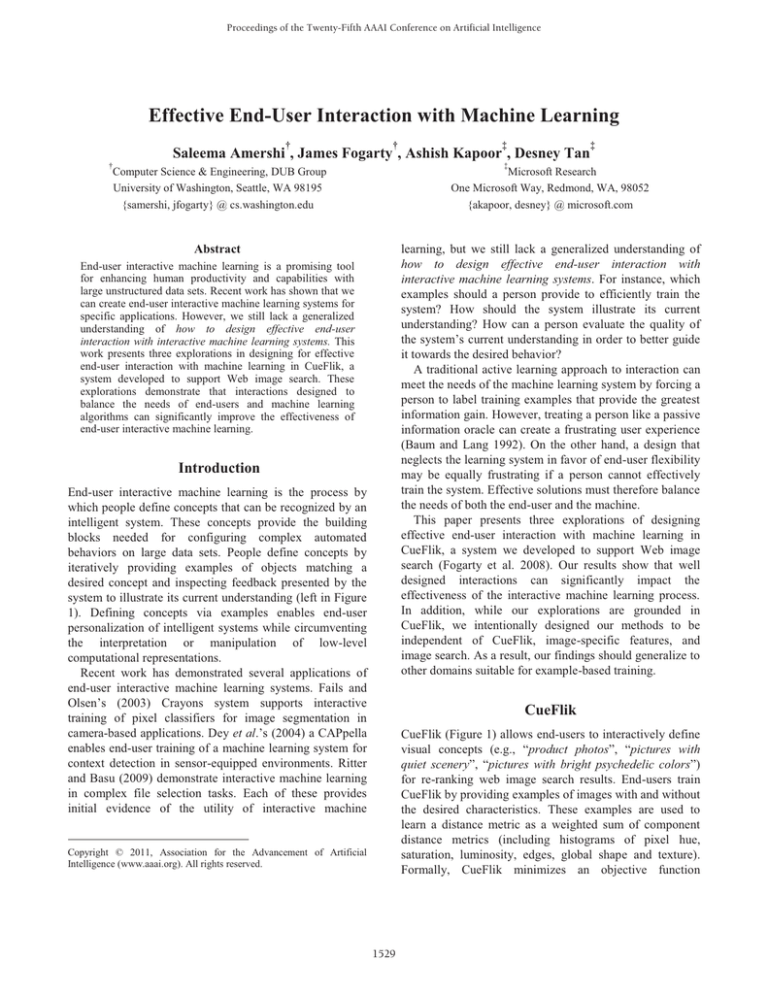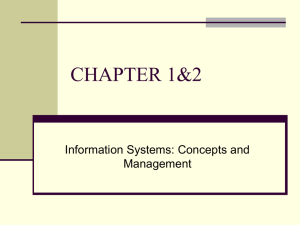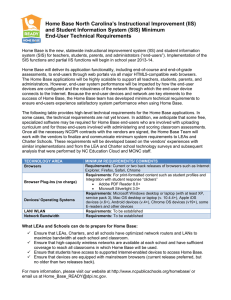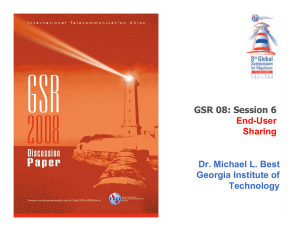
Proceedings of the Twenty-Fifth AAAI Conference on Artificial Intelligence
Effective End-User Interaction with Machine Learning
†
†
‡
Saleema Amershi , James Fogarty , Ashish Kapoor , Desney Tan
†
‡
‡
Computer Science & Engineering, DUB Group
University of Washington, Seattle, WA 98195
{samershi, jfogarty} @ cs.washington.edu
Microsoft Research
One Microsoft Way, Redmond, WA, 98052
{akapoor, desney} @ microsoft.com
Abstract
learning, but we still lack a generalized understanding of
how to design effective end-user interaction with
interactive machine learning systems. For instance, which
examples should a person provide to efficiently train the
system? How should the system illustrate its current
understanding? How can a person evaluate the quality of
the system’s current understanding in order to better guide
it towards the desired behavior?
A traditional active learning approach to interaction can
meet the needs of the machine learning system by forcing a
person to label training examples that provide the greatest
information gain. However, treating a person like a passive
information oracle can create a frustrating user experience
(Baum and Lang 1992). On the other hand, a design that
neglects the learning system in favor of end-user flexibility
may be equally frustrating if a person cannot effectively
train the system. Effective solutions must therefore balance
the needs of both the end-user and the machine.
This paper presents three explorations of designing
effective end-user interaction with machine learning in
CueFlik, a system we developed to support Web image
search (Fogarty et al. 2008). Our results show that well
designed interactions can significantly impact the
effectiveness of the interactive machine learning process.
In addition, while our explorations are grounded in
CueFlik, we intentionally designed our methods to be
independent of CueFlik, image-specific features, and
image search. As a result, our findings should generalize to
other domains suitable for example-based training.
End-user interactive machine learning is a promising tool
for enhancing human productivity and capabilities with
large unstructured data sets. Recent work has shown that we
can create end-user interactive machine learning systems for
specific applications. However, we still lack a generalized
understanding of how to design effective end-user
interaction with interactive machine learning systems. This
work presents three explorations in designing for effective
end-user interaction with machine learning in CueFlik, a
system developed to support Web image search. These
explorations demonstrate that interactions designed to
balance the needs of end-users and machine learning
algorithms can significantly improve the effectiveness of
end-user interactive machine learning.
Introduction
End-user interactive machine learning is the process by
which people define concepts that can be recognized by an
intelligent system. These concepts provide the building
blocks needed for configuring complex automated
behaviors on large data sets. People define concepts by
iteratively providing examples of objects matching a
desired concept and inspecting feedback presented by the
system to illustrate its current understanding (left in Figure
1). Defining concepts via examples enables end-user
personalization of intelligent systems while circumventing
the interpretation or manipulation of low-level
computational representations.
Recent work has demonstrated several applications of
end-user interactive machine learning systems. Fails and
Olsen’s (2003) Crayons system supports interactive
training of pixel classifiers for image segmentation in
camera-based applications. Dey et al.’s (2004) a CAPpella
enables end-user training of a machine learning system for
context detection in sensor-equipped environments. Ritter
and Basu (2009) demonstrate interactive machine learning
in complex file selection tasks. Each of these provides
initial evidence of the utility of interactive machine
CueFlik
CueFlik (Figure 1) allows end-users to interactively define
visual concepts (e.g., “product photos”, “pictures with
quiet scenery”, “pictures with bright psychedelic colors”)
for re-ranking web image search results. End-users train
CueFlik by providing examples of images with and without
the desired characteristics. These examples are used to
learn a distance metric as a weighted sum of component
distance metrics (including histograms of pixel hue,
saturation, luminosity, edges, global shape and texture).
Formally, CueFlik minimizes an objective function
Copyright © 2011, Association for the Advancement of Artificial
Intelligence (www.aaai.org). All rights reserved.
1529
Figure 1. In end-user interactive machine learning (left), a person iteratively provides a system with training examples for a desired
concept. Those examples train a classifier that is applied to the remaining data. A person then inspects presented data and decides how to
best proceed with refining the classifier. CueFlik (right) supports end-user interactive machine learning in Web image search.
enabling effective and lightweight end-user exploration of
multiple potential models (Amershi et al. 2010).
We present the results of our interaction evaluations in
terms of two key measures: quality of end-user-trained
concepts and their efficiency in training. For study details,
please refer to our original publications.
separating positive examples from negative examples
while keeping examples in the same class close together:
f ( weights )
Di, j ¦ ln ¦ e
¦ Di, j i, j ¦
i, j Pos
Neg
i All j All
D i , j where D(i, j) is the distance metric computed as a weighted
sum of CueFlik’s component metrics. The first two terms
correspond to within-class distances. Minimizing the
function therefore favors weights that collapse the positive
and negative classes. The third term considers all
examples, thus favoring maximum separation of classes.
CueFlik uses provided examples to update its distance
metric. It then uses a nearest-neighbor classifier to re-rank
images according to their likelihood of membership in the
positive class. Throughout the iterative training process,
CueFlik presents examples illustrating its current
understanding of the desired concept and end-users decide
how to proceed with improving system understanding.
Illustrating the Current Learned Concept
A fundamental issue in end-user interactive machine
learning is illustrating the system’s current understanding
of a learned concept. An effective illustration can help
people asses the quality of the current concept and in turn
inform whether and how they proceed in training.
We examined two methods for illustrating CueFlik’s
current version of a learned concept: single versus split
presentation (Fogarty et al. 2008). The single method
provides access to the entire set of images, ranked by their
likelihood of membership in the positive class (right in
CueFlik interface, Figure 1). The split method instead
shows only the best and worst matching images in the set
(left in CueFlick interface, Figure 1). The best matches
show a small number of high-certainty positive images
(extremely close to positive training examples). The worst
matches show a small number of high-certainty negative
images (extremely close to negative training examples).
In addition, we experimented with integrating active
learning examples into both the single and split
presentations interfaces. These examples were chosen
using standard active learning heuristics for selecting
examples that provide the system with the most
information gain (e.g., examples the system is currently
most uncertain about, such as examples near the boundary
of the positive and negative classes).
Designing Effective Interactions with CueFlik
There are many possible ways to design the various
interactions during the end-user interactive machine
learning process. In our explorations with CueFlik, we
attempt to move beyond previous naïve or ad-hoc
approaches by designing general techniques that balance
the needs of both end-users and machine learning
algorithms. The techniques we present here target three
important aspects of the end-user interactive machine
learning process: (1) effectively illustrating the current
version of a learned concept (Fogarty et al. 2008), (2)
guiding end-users to select training examples that result in
higher quality concepts (Amershi et al. 2009), and (3)
1530
From our evaluation, we found that participants using
the split presentation created CueFlik concepts of
significantly higher quality, using significantly fewer
training examples, in significantly less time than
participants using the single method. One explanation of
this is that the split presentation encouraged participants to
focus on whether the system’s understanding was mostly
correct (i.e., whether the best and worst matches
corresponded to their desired concept). In contrast,
presenting the entire set of images (single) exposes
participants to images for which the system is more
uncertain (e.g., images in the middle of the ordered set).
These images may have led participants to find relatively
minor inconsistencies, prompting them to continue adding
examples and take more time. Furthermore, as people label
more of these uncertain images, CueFlik may begin to
learn irrelevant aspects of those examples. Interestingly,
neither the presence nor absence of active learning
examples (i.e., examples that are theoretically intended to
provide the machine with the most information about the
model being trained) had a significant effect on participant
ability to train models. These findings suggest further
exploration of how to best guide people to select effective
training examples during interactive machine learning.
f (i )
1 K i , S K S,1S K S ,i
1 K i ,U i KU1i ,U i KU i ,i
where KS,S is the similarity matrix among S, KU-i,U-i is the
similarity matrix among U excluding i, and Ki,S, KS,i, Ki,U-i,
and KU-i,i are each similarity vectors between i and the
respective sets (Amershi et al. 2009). Intuitively, examples
maximizing this ratio are most dissimilar to selected
examples and most representative of those unselected.
Our second strategy emphasizes projected overviews,
selecting instances that illustrate variation along major
dimensions of the positive and negative regions. We first
obtain a set of principle dimensions in each region and then
select examples along each. We use a non-linear projection
technique similar to Principal Component Analysis to
compute principle dimensions, as this best respects the
structure of the underlying data (Amershi et al. 2009). To
select instances that best illustrate the intended variation
(i.e., provide coverage of a single principal dimension but
also vary as little as possible in all other dimensions), we
modify our sensor placement strategy to maximize:
§ 1 K i , S K S,1S K S ,i
f (i ) ¨
1
¨1 K
i ,U i K U i ,U i K U i ,i
©
·§
1
¸¨
¸¨ 1 K K 1 K
i,S
SS
S ,i
¹©
·
¸
¸
¹
where K is the similarity matrix for the principal dimension
for which we are currently selecting a set of representative
examples and K̅ is the similarity matrix for all of the other
principal dimensions (Amershi et al. 2009).
We compared our new overview-based strategies to the
best performing strategy from our initial work (i.e., the
high-certainty strategy presenting the best and worst
matches). We found that our overview-based strategies of
presenting high-value examples guided participants to
select better training examples and train significantly
higher quality concepts than the high-certainty strategy.
However, we also found that participants spent more time
training when using the overview-based strategies.
During our evaluation, we observed that participants
often continued providing additional training examples
even when they did not seem to be further improving a
concept. This obviously increases the training time and we
believed it could also negatively impact final concept
quality. We therefore further analyzed the point where
participants obtained their best learned concept. This
showed that our overviews led participants to train better
best concepts in the same amount of time and with fewer
examples than the high-certainty strategy. This analysis
also showed that all of our interfaces suffered from some
model decay (from best to final concepts). Participant
feedback indicated they were often unable to revert back to
previous model states during training when quality started
to decay (e.g., “it was weird, sometimes it would start out
doing really well, but as I kept going it did worse”). Our
overviews, however, helped to reduce the magnitude of
this decay compared to the high-certainty condition.
Soliciting Effective Training Examples
Our initial exploration showed that the split method of
presenting examples led participants to train better
concepts. This result mixes two possible explanations for
the improvement: (1) the use of a split presentation with a
small number of examples illustrating the positive and
negative regions during interactive refinement of a learned
concept, and (2) that those examples were selected as
representative of the positive and negative regions because
of their high-certainty. We hypothesized that the first of
these explanations is indeed important. However, because
high-certainty examples are extremely similar to already
labeled examples, they provide little additional information
to the machine learning algorithm during training.
We examined two strategies for selecting small sets of
examples of high-value to the machine learning algorithm
that also provide the end-user with an intuitive overview of
the positive and negative regions of a space defined by a
learned concept (Amershi et al. 2009). Our first strategy
presents a global overview, selecting examples to provide
good coverage of the positive and negative regions (left in
CueFlik interface, Figure 1). We use a sensor-placement
strategy (Krause et al. 2008) to select examples, i, that
maximize the mutual information gain between currently
selected, S, and unselected, U, examples (and are therefore
of high quality from the learner’s perspective):
MI (U i; S i) MI (U i; S )
To achieve this, we take a Gaussian Process perspective
and select examples that maximize:
1531
While revision led our participants to create better
quality final models, we still observed some decay in all
conditions. This problem of helping people determine
appropriate stopping points is related to the machine
learning problem of identifying overfitting. Therefore, a
perspective that considers both the human and the machine
introduces new opportunities for solving these and other
open problems in interactive machine learning.
Examining Multiple Potential Models
Participants in our second exploration were unable to
revert back to previous models when they observed that
CueFlik was not behaving in the desired manner. We
hypothesized that this was partly due to an implicit
assumption in prior research about how people should
interact with machine learning. Machine learning systems
learn by generalizing from examples of object classes.
Prior research has thus focused interaction on prompting a
person to answer “what class is this object?” (e.g., Tong
and Chang 2001). Such an approach permits simulated
experiments with fully-labeled datasets. However, treating
a person simply as an oracle neglects human ability to
revise and experiment. We therefore propose that a person
instead consider “how will different labels for these objects
impact the system in relation to my goals?”
Our third exploration examines the impact of end-user
comparison of multiple potential models during the
interactive machine learning process (Amershi et al. 2010).
Comparison of multiple alternatives is a proven technique
in human-computer interaction but has not been explored
in the context of people interacting with machine learning.
We examine this with a history visualization showing
recently explored models and support for revision (see
CueFlik interface in Figure 1). The history contains a plot
of each model’s estimated reliability, updated after every
end-user interaction (e.g., labeling examples). Model
reliability is measured using leave-one-out-cross-validation
on the current set of training examples. The history also
shows snapshots of each model’s top ranked images for
visual comparison. Revision can be achieved by removing
examples directly, via undo/redo, and by clicking directly
within the history to revert back to previous models.
Our evaluation showed that the history visualization led
participants to spend more time and perform more actions
to train concepts without improving overall model quality.
Although the plot used an accepted metric to estimate
model reliability (leave-one-out-cross-validation accuracy),
end-users seemed to use it less like an tool for helping
them interpret model quality and more like a quantity to
maximize (e.g., “I wanted the graph to go up instead of
concentrating on [the results]”). This emphasizes the need
to consider a person’s understanding of the limitations (and
benefits) of accepted machine learning techniques when
designing interactive machine learning systems.
Our evaluation also found that participants readily
adopted revision mechanisms, making use of them in 68%
of their tasks when it was available. Revision also led
participants to achieve better quality final models in the
same amount of time than when revision was not available.
Furthermore, examining and revising actions is consistent
with how people expect to interact with applications. One
participant commented that without revision “it felt a little
like typing on a keyboard without a backspace key”.
Conclusion
In this work we explore how to design effective end-user
interaction with interactive machine learning systems.
While important problems remain, our explorations with
CueFlik demonstrate that careful designs considering the
needs of both end-users and machine learning algorithms
can significantly impact the effectiveness of end-user
interaction. Moreover, many of our techniques are not
specific to image search or features of images. Techniques
like overview-based example selection or revision of
previous models can therefore potentially impact a wide
variety of machine learning based applications.
References
Amershi, S., Fogarty, J., Kapoor, A. and Tan, D. 2010.
Examining Multiple Potential Models in End-User Interactive
Concept Learning. In Proceedings of CHI 2010, 1357-1360. New
York, NY: ACM Press.
Amershi, S., Fogarty, J., Kapoor, A. and Tan, D. 2009. OverviewBased Examples Selection in Mixed-Initiative Interactive
Concept Learning. In Proceedings of UIST 2009, 247-256. New
York, NY: ACM Press.
Baum, E.B. and Lang, K. 1992. Query Learning can work Poorly
when a Human Oracle is Used. In Proceedings of IJCNN 1992, 609614. Washington, DC: IEEE Computer Society.
Dey, A.K., Hamid, R., Beckmann, C., Li, I. and Hsu, D. 2004. a
CAPpella: Programming by Demonstrations of Context-Aware
Applications. In Proceedings of CHI 2004, 33-40. New York,
NY: ACM Press.
Fails, J.A., Olsen Jr., D.R. 2003. Interactive Machine Learning. In
Proceedings of IUI 2003, 39-45. New York, NY: ACM Press.
Fogarty, J., Tan. D., Kapoor, A. and Winder, S. 2008. CueFlik:
Interactive Concept Learning in Image Search. In Proceedings of
CHI 2008, 29-38. New York, NY: ACM Press.
Krause, A., Singh, A. and Guestrin, C. 2008. Near-optimal Sensor
Placements in Gaussian Processes: Theory, Efficient Algorithms
and Empirical Studies. Journal of Machine Learning Research 9 :
235-284.
Ritter, A. and Basu, S. 2009. Learning to Generalize for Complex
Selection Tasks. In Proceedings of IUI 2009, 167-176. New York,
NY: ACM Press.
Tong, S. and Chang, E. 2001. Support Vector Machine Active
Learning for Image Retrieval. In Proceedings of Multimedia
2001, 107-118. New York, NY: ACM Press.
1532







